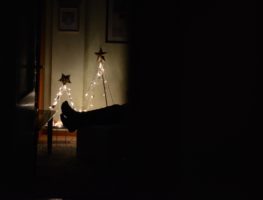Over Christmas time, Willowcreek put on Christmas Eve service(s) that they described as their most ambitious yet. Most noteworthy, according to the newspaper, they used Cirque de Soleil-style acrobats in the presentation of the Christmas story. While some of us were (admittedly) smirking over this – a friend said to me, “they are just trying to be creative in presenting the story of Christ’s birth. What could be wrong with that?” At which point I pondered – at what point is the story no longer the story? Answer – when it becomes a spectacle. According to Paul Ricouer, we know it’s a good story when we “get into it,” when we see ourselves “emploted” into the story. This is the idea behind remembering the story, rehearsing it in worship (and the Eucharist), true anamnesis (1 Cor 11:24). The spectacle however turns us passive no longer able to participate in the story. The question is: did Willowcreek turn the story of the Christ child into a spectacle with the use of acrobats? Did the acrobats becomes so mesmerizing that those who came to see were caught up in the spectral gaze, detached and mesmerized, made totally inert as onlookers no longer able to participate in the story? Because when the story becomes a spectacle, the story is no longer a story. And we have gone from an act of worship to an act of spectatorship, from an act of participation to a spectral gaze.
According to John Milbank (Being Reconciled, p. 31), Augustine described the way Romans would go to the theatre and enjoy suffering and violence acted out on the stage as those caught in the spectral gaze. Augustine said the thrill of the spectral gaze depended upon “an absolute bar against reciprocal participation sealed by a double passivity.” (p.31). This spectral gaze made the onlooker doubly passive (according to Milbank) because a.) the scene from the outset was exhibited ONLY to be watched, and b.) the people watching were confined from going there for any other purpose that mere reception, mere spectatorship. They were safe from the violence, were prohibited from participating, and there was not any other purpose to witness this violence in this way that getting a “cheap thrill.” (milbank might argue that Mel Gibson’s Passion of the Christ was such a spectacle). This is markedly different than a worship gathering and a rehearsal of the Christ story where we called to participation. Milbank says this enables a perverse enjoyment of suffering. And so at this point the scene becomes a spectacle.
Now Milbank is using the “spectral gaze” in this part of Being Reconciled to argue for something totally different than I am here. He is trying to show the perverse complicity in violence inherent in pacificist positions by their “passivity.” Something I don’t agree with Milbank on. Nonetheless, I believe his analysis does help us understand what could be wrong with Christmas Eve services that use Acrobats.
For it is when we attempt to make the Christmas Eve service into a spectacle, when we try to hyper intensify the reality of the Son being born a babe to attract onlookers, THAT WE ACTUALLY REMOVE OURSELVES AND THE ONLOOKERS FROM THAT REALITY. We make the birth of the Son a spectacle to get fascinated by, enjoy as a show, foreclosing the possibility of participating in it. In other words, you cannot evangelize with a spectacle. Isn’t that ironic?
We love to intensify reality. But the spectral gaze intensifies the reality turning it into hyper reality one step removed from reality. Participation is pre-empted. According to Baudrillard, this is the last stage of a culture’s semiotics when we go to signs bearing no relation to reality whatsoever. It is “pure simulation.” Ironically, when we reach this point in our services, they bear no relation to reality any longer. They are simulating Christ performing a simulacrum of the birth of Christ. Ironically, in so doing, we in effect separate people from the reality of Christ instead of drawing them closer. And we cut off all participation.
Some will say, but they have someone speak a message at the end (notice the newspaper article)! And they ask people to make a decision. To which I ask, how can anyone respond authentically once they’re caught up in the passivity of the spectral gaze? But ok, I’ll take an altar call here to get some form of participation out of the spectral gaze. It ain’t the Eucharist but it is something.
Some will say, Dave you’re up tight. Let us be creative. To which I reply that I believe art is absolutely essential to worship and the embodiment of the gospel. In a world moved past modernity, we must embody the gospel and the reality of Father, Son Holy Ghost so as to reshape imaginations under the work of the Spirit in worship. But we will have to discern the difference between art as worship from spectacle. Our graphics motion icons in our service are beautiful, but we have to watch carefully. For they must not dwarf the Story. They must invite into the Story.
Perhaps Willowcreek did the acrobats with this kind of discernment. In which case I take back everything I said that might have implicated them. Nonetheless the exercise has been good for me to think all over again why we must avoid the spectacle when it comes to the worship of our God Incarnate.






Missio Alliance Comment Policy
The Missio Alliance Writing Collectives exist as a ministry of writing to resource theological practitioners for mission. From our Leading Voices to our regular Writing Team and those invited to publish with us as Community Voices, we are creating a space for thoughtful engagement of critical issues and questions facing the North American Church in God’s mission. This sort of thoughtful engagement is something that we seek to engender not only in our publishing, but in conversations that unfold as a result in the comment section of our articles.
Unfortunately, because of the relational distance introduced by online communication, “thoughtful engagement” and “comment sections” seldom go hand in hand. At the same time, censorship of comments by those who disagree with points made by authors, whose anger or limited perspective taints their words, or who simply feel the need to express their own opinion on a topic without any meaningful engagement with the article or comment in question can mask an important window into the true state of Christian discourse. As such, Missio Alliance sets forth the following suggestions for those who wish to engage in conversation around our writing:
1. Seek to understand the author’s intent.
If you disagree with something the an author said, consider framing your response as, “I hear you as saying _________. Am I understanding you correctly? If so, here’s why I disagree. _____________.
2. Seek to make your own voice heard.
We deeply desire and value the voice and perspective of our readers. However you may react to an article we publish or a fellow commenter, we encourage you to set forth that reaction is the most constructive way possible. Use your voice and perspective to move conversation forward rather than shut it down.
3. Share your story.
One of our favorite tenants is that “an enemy is someone whose story we haven’t heard.” Very often disagreements and rants are the result of people talking past rather than to one another. Everyone’s perspective is intimately bound up with their own stories – their contexts and experiences. We encourage you to couch your comments in whatever aspect of your own story might help others understand where you are coming from.
In view of those suggestions for shaping conversation on our site and in an effort to curate a hospitable space of open conversation, Missio Alliance may delete comments and/or ban users who show no regard for constructive engagement, especially those whose comments are easily construed as trolling, threatening, or abusive.